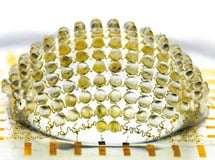The compact cameras are ideal for applications demanding wide fields of view are important — that includes video surveillance applications and machine vision.
According to the researchers, insect eyes are made up of hundreds or even thousands of light-sensing structures called ommatidia. Each contains a lens and a cone that funnels light to a photosensitive organ. The long, thin ommatidia are bunched together to form the hemispherical eye, with each ommatidium pointing in a slightly different direction.
The beauty of this structure is that it gives insects a wide field of view, with objects in the periphery just as clear as those in the centre of the visual field, as well as high motion sensitivity – ideal for video analytics. Better still, the design also allows serious depth of field — objects are in focus whether they’re nearby or at a distance. We’d love to report numbers but nothing to hand as yet.
The biggest challenge in mimicking the structure of an insect eye in a camera is that electronics are typically flat and rigid, says John Rogers, a materials scientist at the University of Illinois at Urbana-Champaign. “In biology, everything is curvy,” he says.
The device researchers have built comprises an array of microlenses connected to posts that mimic the light-funnelling cones of ommatidia, layered on top of a flexible array of silicon photodetectors. Lens–post pairs are moulded from a stretchy polymer called an elastomer. A filling of elastomer dyed with carbon black surrounds the structures, preventing light from leaking between them. The lens is about 1 centimetre in diameter.
“The whole thing is stretchy and thin, and we blow it up like a balloon” so that it curves like a compound eye, says Rogers.
The current prototype produces black-and-white images only, but Rogers says a colour version could be made with the same design.
Rogers describes the camera as a “low-end insect eye”. It contains 180 artificial ommatidia, about the same number as in the eyes of a fire ant (Solenopsis fugax) or a bark beetle (Hylastes nigrinus).
Rogers says, his team can now increase the resolution of the camera by incorporating more ommatidia. “We’d like to do a dragonfly, with 20,000 ommatidia,” he says, which will require some miniaturization of the components.
